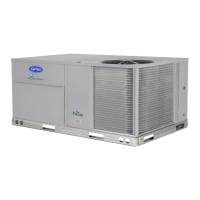28
Configuration
ECON
EC.MN should always be set for
the minimum damper position.
If the unit is equipped with an outdoor air flow station, the
following points in Configuration
ECON
CFM.C need to
be set.
If equipped with an outdoor flow station, make sure
Configuration
ECON
CFM.C
OCF.S is enabled. If an
outdoor air cfm station is used, then the economizer will con-
trol to cfm, not a position, as long as the sensor is valid. There-
fore, Configuration
ECON
CFM.C
O.C.MX super-
sedes Configuration
ECON
EC.MN. Without CFM or en-
thalpy control, the outdoor-air dampers will open to minimum
position when the supply fan is running. Outdoor-air dampers
will spring-return closed upon loss of power or shutdown of the
supply fan.
Indoor Air Quality Configurations
DEMAND CONTROL VENTILATION — Under Configu-
ration
IAQ
DCV.C, the following configuration parame-
ters should be set to establish the minimum and maximum
points for outdoor air damper position during demand con-
trolled ventilation (DCV):
EC.MN Economizer Min.Position
IAQ.M IAQ Demand Vent Min.Pos.
O.C.MX Economizer Min. Flow
O.C.MN IAQ Demand Vent Min. Flow
Configuration
IAQ
DCV.C
IAQ.M is used to set the
absolute minimum vent position (or maximum reset) under
DCV.
Configuration
IAQ
DCV.C
EC.MN is used to set the
minimum damper position (or with no DCV reset). This is also
referenced in the economizer section.
Configuration
IAQ
DCV.C
O.C.MX is used only
with the outdoor airflow station and will supersede
Configuration
IAQ
DCV.C
EC.MN as long as the out-
door air cfm sensor is valid.
Configuration
IAQ
DCV.C
O.C.MN is used only
with the outdoor airflow station and will supersede
Configuration
IAQ
DCV.C
IAQ.M as long as the out-
door air cfm sensor is valid.
Exhaust Configurations — The following exhaust
options should be configured.
Configuration
BP
BF.CF=1 — Under Configuration
BP the following configurations may be adjusted:
Under Configuration
BP
B.V.A the following configu-
rations may be adjusted:
BP.FS VFD/Act. Fire Speed
BP.MN VFD/Act. Min. Speed
BP.MX VFD Maximum Speed
Configuration
BP
BP.CF=2 (Return Fan Tracking Con-
trol) — Under Configuration
BP the following configura-
tions may be adjusted:
BP.SP Building Pressure Setpoint (see note below)
Under Configuration
BP
B.V.A the following configu-
rations may be adjusted:
BP.FS VFD/Act. Fire Speed
BP.MN VFD/Act. Min. Speed
BP.MX VFD Maximum Speed
Under Configuration
BP
FAN.T the following config-
urations may be adjusted:
FT.CF Fan Track Learn Enable (see note below)
FT.TM Fan Track Learn Rate (see note below, not
used when Fan Track Learning is disabled)
FT.ST Fan Track Initial DCFM
FT.MX Fan Track Max Clamp (see note below, not
used when Fan Track Learning is disabled)
FT.AD Fan Track Max Correction (see note below,
not used when Fan Track Learning is disabled)
FT.OF Fan Track Internl EEPROM (see note below,
not used when Fan Track Learning is disabled)
FT.RM Fan Track Internal Ram (see note below, not
used when Fan Track Learning is disabled)
FT.RS Fan Track Reset Internal (see note below, not
used when Fan Track Learning is disabled)
NOTE: These configurations are used only if Fan Track Learn-
ing is enabled. When Fan Track Learning is enabled, the con-
trol will add an offset to the Fan Track Initial DCFM
(Configuration
BP
FAN.T
FT.ST) if the building pres-
sure deviates from the Building Pressure Set Point (BP.SP).
Periodically, at the rate set by the Fan Track Learn Rate
(FT.TM) the delta cfm is adjusted upward or downward with a
maximum adjustment at a given instance to be no greater than
Fan Track Max correction (FT.AD). The delta cfm can not
ever be adjusted greater than or less than the Fan Track Max
Clamp (FT.MX).
Set Clock on VFD — The clock set mode is used for
setting the date and time for the internal clock of the VFD. In
order to use the timer functions of the VFD control, the internal
clock must be set. The date is used to determine weekdays and
is visible in the fault logs. Refer to the VFD section in Appen-
dix D on page 211 for information on operating the VFD and
using the keypad.
To set the clock, perform the following procedure from the
VFD keypad:
1. Select MENU (SOFT KEY 2). The Main menu will be
displayed.
2. Use the UP or DOWN keys to highlight TIME AND
DATE SET on the display screen and press ENTER
(SOFT KEY 2). The clock set parameter list will be
displayed.
3. Use the UP or DOWN keys to highlight CLOCK VISI-
BILITY and press SEL (SOFT KEY 2). This parameter
is used to display or hide the clock on the screen. Use the
UP or DOWN keys to change the parameter setting. Press
OK (SOFT KEY 2) to save the configuration and return
to the Clock Set menu.
4. Use the UP or DOWN keys to highlight SET TIME and
press SEL (SOFT KEY 2). Use the UP or DOWN keys to
change the hours and minutes. Press OK (SOFT KEY 2)
to save the configuration and return to the Clock Set
menu.
5. Use the UP or DOWN keys to highlight TIME FORMAT
and press SEL (SOFT KEY 2). Use the UP or DOWN
keys to change the parameter setting. Press OK (SOFT
KEY 2) to save the configuration and return to the Clock
Set menu.
6. Use the UP or DOWN keys to highlight SET DATE and
press SEL (SOFT KEY 2). Use the UP or DOWN keys to
change the day, month, and year. Press OK (SOFT KEY
2) to save the configuration and return to the Clock Set
menu.
7. Use the UP or DOWN keys to highlight DATE FOR-
MAT and press SEL (SOFT KEY 2). Use the UP or
DOWN keys to change the parameter setting. Press OK
UEFC Unoccupied Economizer Free Cooling
ACT.C Economizer Actuator Config
BP.SP Building Pressure Set Point
BP.SO BP Set Point Offset

